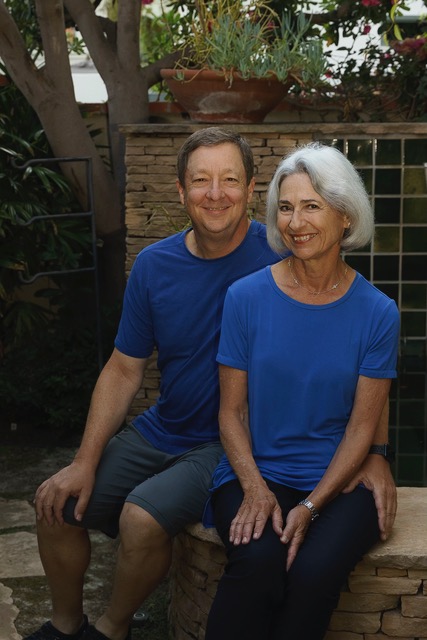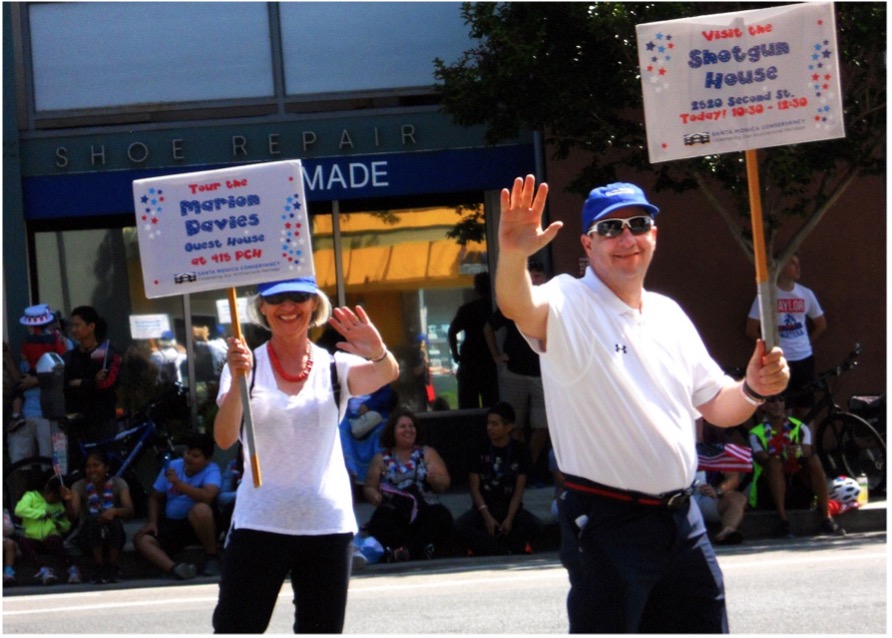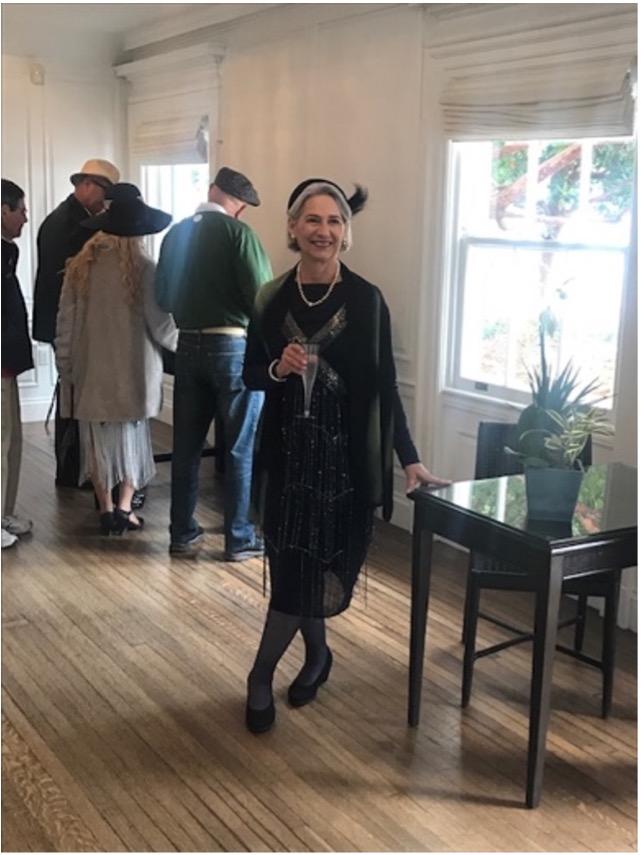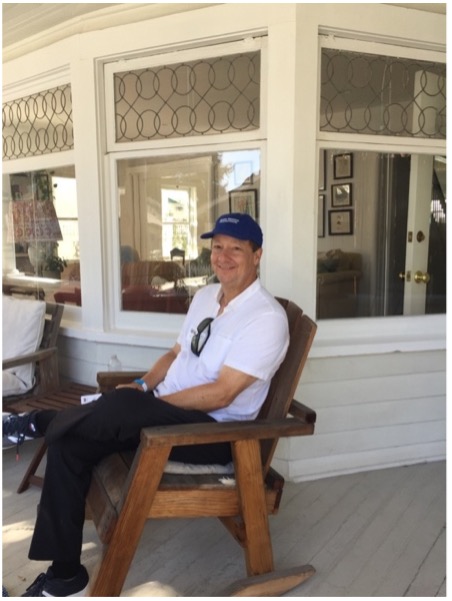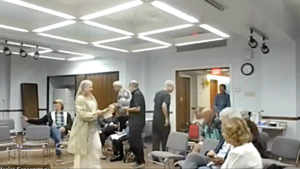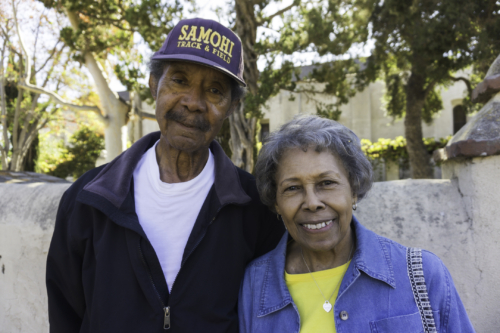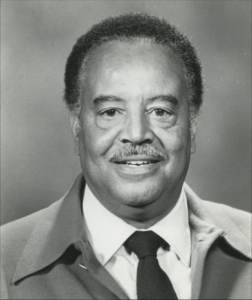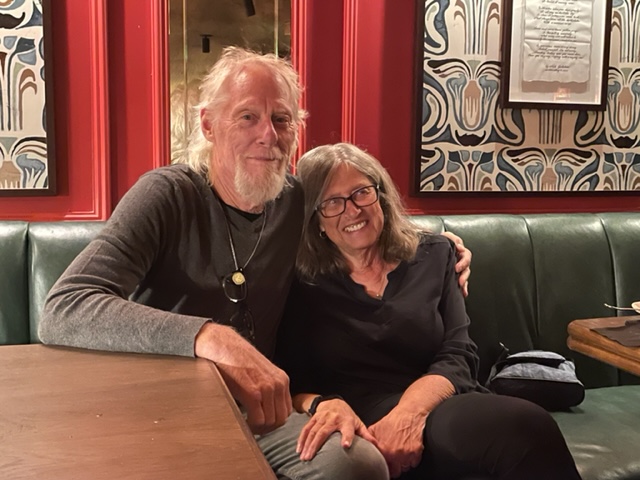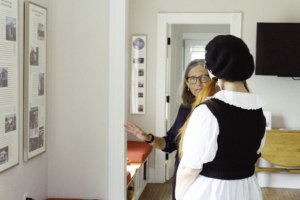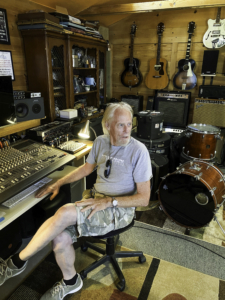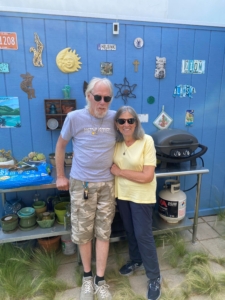(Santa Monica) City Council members make crucial decisions on landmark nominations, zoning constraints and incentives, and other matters affecting our cultural resources. To help our members and friends evaluate the candidates’ understanding and knowledge of their important role in historic preservation, we sent questionnaires to all candidates. Their responses, along with our questions, are below.
For your convenience, you can use keys Command + F (Mac) or Control + F, to find the answers from your desired candidate. NOTE: Responses were not received from Oscar de la Torre. Answers are lightly edited for clarity.
Questions Posed to City Council Candidates
1) What personal experience have you had with landmarks or other meaningful places in the city, other than the compelling Santa Monica Municipal Pier, that was formative to your perspectives toward historic preservation? Please describe.
2) What do you see as the biggest barrier to Santa Monica’s stated goal of preserving its historic, architectural, and cultural resources? What obstacles or disincentives to historic preservation are you aware of?
3) How do you envision the interaction between historic preservation and new housing development so the goals of both programs work together? Please describe an example, real or hypothetical, of a landmark that has been successfully adapted to accommodate new housing.
4) What role, if any, do you think historic preservation can play in the economic revitalization of Santa Monica’s retail centers in Downtown and in Neighborhood Commercial districts?
Council Candidate Answers in Alphabetical Order

Phil Brock
1) I was the chair of the Historic San Vicente Coalition, a group of residents who fought to landmark the garden and courtyard apartments on San Vicente Blvd. that were constructed between the 1930s and 1960. I rallied residents, presented documents and videos, and successfully had the City Council landmark the many rent-controlled apartments on San Vicente Blvd over the course of 18 months. This landmarking effort solidified that rent-controlled housing will remain on San Vicente Blvd for decades to come, and a more humane way of constructing rental housing will continue to be a way of life on our San Vicente Blvd.
2) Quite frankly, the land values of property in Santa Monica hamper preservation, which is the major obstacle to creating more historically preserved sites. In addition, the ethos in the Los Angeles area for decades discounted preservation and valued new construction. Belatedly, Santa Monica and all of Los Angeles began to take a harder look at our history and began to treasure the old and adapted structures. On a separate note, we need to make sure that the conservation of our cultural history is paramount to our city as we near our 150th birthday as a city and that obstacles to applying for landmark status are minimized.
3) The Clock Tower Building on Santa Monica Blvd and the 100 Wilshire Building are hypothetical examples of historic Santa Monica high rises that could be adaptively repurposed into housingover the coming decades. The upcoming “Gehry” hotel and associated buildings also can provide a good primer on how historic structures can interact with impressive new developments to create 21st Century possibilities.
4) First, it is always more environmentally sensitive to reuse a structure rather than build a new one, so whenever possible, adaptive reuse should be considered. Creating a vibrant downtown that works for all should include blending the old with the new. As a case study, Pasadena’s Colorado Blvd and the surrounding area created a vibrant retail, dining, film, and music district that bases its charm on preserving an entire area. You might also look at San Luis Obispo and Santa Barbara as two other cities that value their history, create a better base for tourism, and characterize human-scale places to live, work, and play. It bodes well for a Santa Monica that must embrace its past while looking into the future.

Dan Hall
1) It is accurate to state that the Santa Monica Pier has been a major part of my connection with historic preservation here in Santa Monica. As Chair of the Santa Monica Pier Board, I am leading a strategic effort to reconnect the Pier Corporation’s mission, vision, and values to promoting and preserving the classic pleasure pier experience. Landmarks Commissioner Dolores ‘Dolly’ Sloan has helped me understand and learn about many of the landmarked historic buildings in Santa Monica, and through my attendance at Committee for Racial Justice meetings and helping to lead the Santa Monica Democratic Club’s Diversity and Inclusion Committee, I have learned a lot about our history of Belmar, Broadway, and the Ebony Beach Club. In cities like ours, racial justice and historic preservation have deep ties to each other and must be considered in balance.
2) Right now, the biggest barrier to Santa Monica’s goal of historic preservation is our extremely tight budget. In more abundant years, I would like to see the City invest in commemorating our history and historic places through greater storytelling, plaques, and signage in our historic districts, on our buildings, and in our parks.
3) With regards to development, I think there are ways to use parcels for greater purposes such as affordable housing while still preserving unique heritage sites. For example the incorporation of the Nikkei Hall in the development at 14th and Michigan. Similarly, I am pleased with the incorporation of the historic buildings at the Gehry Project on Ocean Ave.
4) There are some really neat historic signs and facades of iconic Santa Monica buildings and businesses in our Downtown and Neighborhood Commerical districts. I love seeing our old theaters repurposed for retail if they have to close – this is something I’ve been thinking about lately with the closing of the AMC 4 on the Promenade. As we redevelop properties – and we must as a city that continues to grow – we should consider ways we can preserve our history while also moving forward further into the 21st century.
Wade Kelley
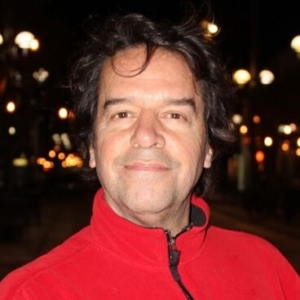
Wade Kelley
I first came back to Santa Monica as an adult attending the Second City training center and the Second City theater was at the Mayfair theater on Santa Monica Boulevard, which I guess was previously the Majestic, and originally the Santa Monica Opera House, so that is quite a historic Santa Monica landmark! I was glad I got to perform on that stage as part of the training center. I’m glad that the building was saved, even though now it is a shoe store, with I am told, expensive apartments above.
We are in a housing crisis, a homelessness crisis! Santa Monica needs to be part of the solution. Kamala Harris wants to build 3 million units of housing in her first term in office ending this housing crisis. That means that cities like Santa Monica, have to step up and build more housing… More affordable housing. Instead of pushing all the poor people out into the desert, Santa Monica needs to integrate more, and by building more affordable Housing and housing the 1% of its population that are homeless, we will help to better integrate Santa Monica, which is now over 70% white. So, I am all for saving important historical landmarks. But, not at the detriment of housing the homeless! And, any leader who proposes to use the 200 acres of land that will be opened up by the Santa Monica airport land. Any leader who proposes to use that solely for a park and recreation, during a housing crisis, a homelessness crisis… is not only irresponsible, but inhumane. There are too many people working in Santa Monica that are unable to live in Santa Monica, therefore adding to traffic, pollution, and travel time for those employees… This during a climate crisis! Santa Monica‘s population has grown by very little since 1970, while the rest of California has grown by 20 million. Santa Monica needs to build more affordable housing and work towards solving this housing crisis, homelessness crisis, integrating, And making life better for all, Santa Monicans!
We can find ways to save the history of Santa Monica, and using buildings for housing. Let’s work towards let’s work towards Equal rights, equal justice, equal opportunity, and building a better history for all Santa Monicans.

Ericka Lesley
1) My commission experience with the Landmarks Commission is in regards to 1665 Appian Way. It is in my opinion that the Landmarks Commission is in need of diverse voices to give thought to different perspectives and the harm that the the lack of those different voices may cause. 1665 Appian Way was the home of Mr. Stotler who drove out Black business owners and helped red line the city to prevent people of color from accessing home ownership.
2) Education of how to utilize historic, architectural and cultural resources in a way to create something new while preserving our historical assets on a large platform. The high cost of conversion is a deterrent to the development of new construction.
3) I would have to look into some of the successful models in Northern California. I have discovered some of these models in Sacramento. There are beautiful historically landmarked buildings that have modern apartments on the inside. We can utilize these types of models here to preserve these buildings while creating new housing opportunities.
4) Our landmarked and historical buildings can contribute to our economy by creating historical destinations throughout the city and creating buzz around these destinations. To draw in more international tourism while sparking the interest of our local communities.
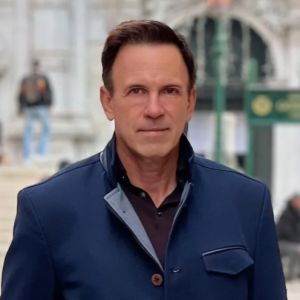
John Putnam
1) As a resident of Santa Monica for about 30 years, I’ve witnessed firsthand the city’s evolution from a laid-back, middle-class community to an overdeveloped landscape. Some of this change is inevitable, given the broader gentrification along the entire coastline. However, much of it stems from a lack of vision and an unfortunate short-sightedness. It’s hard to understand why a centrally located beach city—home to a world-renowned Pier, an open-air Promenade, and a Civic Center—isn’t thriving as a premier regional and international destination. With the right approach, these landmarks could be revitalized, preserved, and given the resources to flourish. Instead, there seems to be a rush to let these valuable assets decline, label them as surplus, and convert them into housing without considering their broader value to our city’s identity and future. If elected, I’m committed to bringing a holistic perspective and advancing policies that prioritize a balanced approach, ensuring Santa Monica remains a vibrant and sustainable destination for future generations.
2) Santa Monica’s primary challenge in achieving its goal of safeguarding historic, architectural, and cultural assets lies in the absence of a clear vision for how these treasures can coexist within a high-demand economic framework. There is a lack of understanding about what it means to strike a balance between development and maintaining a distinctive, invaluable economic identity. There needs to be a much better balance between saving our historic assets through re-purposing as opposed to losing them through redevelopment. I was particularly saddened by the decision to approve demolition of the Bay Films building at 631 Colorado. Preserving our heritage while shaping a lively and relevant future has not been given the policy focus it deserves. If elected, I am committed to making this a priority.
3) Wilshire Boulevard has seen several redevelopment projects that thoughtfully incorporated historic elements, like the revitalization of the Mayfair Theatre and the Streamline Moderne façade between 5th and 6th streets. These projects have skillfully integrated original architectural features into new mixed-use spaces. For example, the Mayfair project brought ground-floor retail, 34 residential units, and underground parking into a single, cohesive site. With an asset as significant as the Civic Center, there’s even greater potential for creating high-value, multi-use facilities that enhance the downtown experience. Finding the right public-private partnership for such a transformation is essential. In fact, given the city’s unfavorable financial trajectory, seriously pursuing effective public-private partnerships to leverage the city’s iconic structures in the revitalization of its commercial environment is not optional. When done well, this approach not only preserves our architectural heritage but also contributes meaningfully to a vibrant, integrated vision for our city’s future.
4) Preserving our historic landmarks can significantly enhance the appeal of Santa Monica’s retail areas, both downtown and in local commercial districts. In an economy fueled by both visitors and residents, these unique assets play a crucial role in defining the character of our city and attracting foot traffic.
Ellis Raskin

Ellis Raskin
1) Historic preservation is one of my passions. That being said, my experience with historic preservation comes from my work as a Planning Commissioner, as an environmental attorney and as a community activist. A significant portion of my legal work involves advising public agencies, community stakeholders, and other parties regarding the California Environmental Quality Act (“CEQA”). When public agencies conduct an environmental review that is required by CEQA, the agency must study (and potentially mitigate) impacts to historic resources. I regularly work alongside historians and other experts to ensure that potential impacts are studied appropriately and that impacts are either prevented or minimized.
As a community activist, I have fought to preserve and memorialize key historic resources. In 2021, for example, I appealed the Landmarks Commission’s approval of a landscape plan that would have radically altered a historic apartment courtyard in the San Vicente Courtyard Apartments Historic District. I ultimately reached a settlement with the property owner that led to the preservation of key landscape features, including several mature trees. To give just a few other examples, I advocated for the preservation of the historic sycamore tree at 1122 California Avenue, and I have called for greater protections for historic apartment buildings in the Pico Neighborhood.
I have also had the opportunity to work on key issues relating to local history as a City of Santa Monica Commissioner. From 2017-2019, I served on the Santa Monica Urban Forest Task Force’s Heritage Tree Subcommittee. I also served on the Santa Monica Planning Commission from 2020-2024. The Planning Commission regularly reviews applications for projects that involve historic resources. When crafting long-term planning strategies, the Planning Commission must identify strategies for balancing long-term growth and development plans with historic preservation objectives. I worked with my colleagues to ensure that projects appropriately respected requirements for historic preservation.
And finally, I have been an advocate for addressing (to the extent possible) past and ongoing injustices to Black and Latino families. As a Planning Commissioner, I support programs that would give a right to return to families that were displaced by the construction of the I-10 Freeway or the Civic Center. I have also advocated for making meaningful efforts to address and compensate, in whatever way we can, the theft of generational wealth from our city’s residents. Specifically, I support monetary compensation for Silas White’s family and other families who sadly had homes, businesses, and lives stolen from them by our City.
History is still being lived and felt today, and I look forward to working with the Conservancy and other community leaders as a City Councilmember to honor our history and to bring attention to key issues and past injustice.
2) Local historic preservationists face numerous challenges. The City is lacking key resources, and there are a number of other long-term obstacles that affect historic preservation. One crucial priority is for the City to hire a full-time historic preservation planner to support the work of the Landmarks Commission. The Landmarks Commission needs to be given the tools, resources, and authority necessary to effectively protect Santa Monica’s historic resources. This will inevitably require additional funding, and it will also require careful collaboration with community stakeholders. It will also be important to ensure that our City’s landmarking laws and policies appropriately address contributions and the history of historically marginalized groups.
Development pressures are another key issue. Santa Monica will need to build nearly 9,000 new housing units by 2029 to meet its Regional Housing Needs Allocation. City leaders will need to diligently enforce our Landmarks Ordinance, and for projects that are subject to CEQA review, the City will need to ensure that impacts to historic resources have been adequately disclosed, analyzed, and mitigated through the CEQA process.
The City also needs to empower local citizens and community organizations (including the Santa Monica Conservancy) to be partners in the fight to protect local history. The Conservancy and other not-for-profit organizations should not be forced to pay exorbitant fees to nominate landmarks, and City leaders need to work collaboratively with local organizations. Our leaders must take the time to listen to historic preservationists, and we all must make every effort to preserve local history for future generations.
3) Supporting our housing goals and advancing historic preservation are two critically important objectives, and they are not mutually exclusive. As a member of the Planning Commission, I worked with City staff and other community stakeholders to develop crucial updates to our City code that will, hopefully, incentivize the adaptive reuse and preservation of existing buildings and historic structures. We worked with subject-matter experts to identify strategies that will allow for existing structures to be incorporated into new developments, or preserved entirely.
Locally, we have seen some great examples of historic properties that were successfully rehabilitated (e.g., 227 Beach Street) or adaptively reused as part of a housing project (e.g., 211 Alta). There are other interesting adaptive reuse examples outside of Santa Monica that can serve as a guide for potential future opportunities (e.g., 2121 Webster Street in San Francisco, which was recently profiled by the Terner Center). As we continue to see the market for commercial office and retail space evolve in Santa Monica, I hope we identify additional opportunities to adaptively reuse underutilized non-residential spaces to meet our community’s housing needs.
4) Preserving and protecting both legacy businesses and historic structures Downtown and in Neighborhood Commercial districts will be crucial to our City’s long-term economic development. Santa Monica’s leaders should continue to explore financial incentives and regulatory streamlining for businesses and property owners who preserve and protect historic structures. Likewise, Santa Monica should partner with community organizations to proactively seek landmark protections for structures in Downtown and Neighborhood Commercial districts that are at risk of loss. Commercial gentrification will only continue to get worse if our leaders do take bold steps to protect legacy businesses in Santa Monica.

Dr. Vivian Roknian
1) As a lifelong resident of Santa Monica, I have witnessed firsthand the gentrification and transformation of our city from a laid-back, middle-class community into a rapidly developing, often unrecognizable, hub. While change is inevitable, I believe that we have lost some of the unique charm and identity that made Santa Monica so special. This shift, in many ways, has been due to a lack of long-term vision and an emphasis on short-term redevelopment goals, rather than preserving the balance between progress and heritage.
One experience that profoundly shaped my perspective on historic preservation is watching the slow decline of Santa Monica’s Civic Center. As a child, I remember the pride the community had in that space—a world-class civic landmark. Over time, its gradual disuse and neglect have felt like a missed opportunity to honor our city’s history. When I see discussions to redevelop significant pieces of land into housing without considering their historical or cultural value, I am reminded of the importance of preserving these spaces.
Landmarks like the Civic Center, the Promenade, and the Pier are not just remnants of our past—they are vital pieces of our future. They should be seen as the anchors that keep Santa Monica’s identity intact amidst the inevitable change. As a community, we must protect and breathe new life into these spaces, so they can continue to serve as gathering places, as they were intended.
If elected, I will advocate for policies that ensure our city’s historic and cultural landmarks are preserved and revitalized, so they can thrive in the broader context of making Santa Monica a world-class destination—one that values both progress and preservation. We need a forward-thinking vision that balances development with maintaining our heritage, and I’m committed to bringing that balance to the table.
2) The biggest barrier to Santa Monica’s goal of preserving its historic, architectural, and cultural resources is the absence of a cohesive vision that integrates preservation into the city’s broader economic model. Too often, preservation is seen as being at odds with progress, rather than being part of a balanced approach that enhances both the city’s cultural identity and its economic vitality.
One of the main obstacles I see is the lack of incentives for property owners and developers to preserve historical structures. Without a clear financial or regulatory framework that encourages preservation, many are inclined to prioritize redevelopment, seeing it as more profitable in the short term. This, in turn, leads to the disuse or demolition of sites that carry immense cultural and architectural significance.
Moreover, there has been little focus on how these historic landmarks can be leveraged to create a thriving, unique destination that both serves residents and attracts visitors. The tendency has been to favor new developments, often at the expense of Santa Monica’s rich history, which should be a key asset in shaping its future. Preserving these spaces should not be seen as a hindrance to progress but rather as an essential part of what makes Santa Monica a vibrant and distinctive city.
If elected, I will work to ensure that preservation becomes a policy priority by integrating our historic resources into the city’s economic model, providing incentives for preservation, and ensuring that our past has a meaningful place in our future. The irreplaceable character of SantaMonica lies in its ability to balance development with the preservation of its cultural heritage, and I am committed to fostering that balance.
3) I believe historic preservation and new housing development can and should work hand-in-hand to create a city that respects its past while meeting the needs of its present and future. When done thoughtfully, preservation does not have to impede progress but can instead be an asset to new development, creating unique spaces that offer character and historical significance while addressing housing needs.
A great example of this is the redevelopment of the Mayfair Theatre on Wilshire Boulevard, where the original façade of this classic structure was successfully preserved and integrated into a mixed-use development. The project retained the theater’s architectural charm, while incorporating ground-floor retail, 34 apartment units, and underground parking. This balance between historic preservation and modern use demonstrates how we can honor the past while adapting to contemporary needs.
Similarly, larger and more iconic structures like the Civic Center could function as high-value assets with the right vision. By partnering with private and public entities, we could transform such spaces into thriving, mixed-use destinations that serve as both community hubs and historical landmarks. This approach not only preserves the cultural and architectural significance of the site but also integrates it into the city’s economic and housing goals.
The key to success lies in finding the right partners who share a commitment to both preservation and progress, ensuring that the revitalization of historic landmarks can contribute to the broader goals of economic development and housing availability. With the right approach, I believe we can create a Santa Monica that honors its history while meeting the challenges of the future.
4) I believe historic preservation can play a vital role in the economic revitalization of Santa Monica’s retail centers, both Downtown and in our Neighborhood Commercial districts. Preserving and revitalizing historic landmarks creates a unique sense of place, distinguishing Santa Monica from other urban areas and making it more attractive to both residents and visitors. In a city driven by tourism, local commerce, and community engagement, leveraging the character and cultural significance of our historic assets can be a powerful tool for economic growth.
When we preserve iconic buildings and integrate them into retail or mixed-use developments, we create spaces that are not only functional but also carry the charm and authenticity that people seek when choosing where to shop, dine, or spend time. For example, projects like the Mayfair Theatre and other redevelopments on Wilshire Boulevard have shown how historic façades can be integrated into modern, mixed-use spaces that appeal to residents and visitors alike. This blend of old and new adds richness to the urban landscape, making it more vibrant and appealing.
Historic preservation adds a unique value to our commercial districts, offering something that newly built developments often lack—a deep connection to the city’s past, which enhances the overall experience of shopping, dining, or living in these areas. By preserving the cultural and architectural identity of Santa Monica, we can create a more distinctive and engaging environment that attracts foot traffic and supports local businesses.
In short, historic preservation isn’t just about protecting our past—it’s about shaping a more dynamic, economically vibrant future. By highlighting our city’s unique heritage, we can ensure that Santa Monica remains a destination of choice for both residents and visitors, driving economic revitalization in our retail centers.
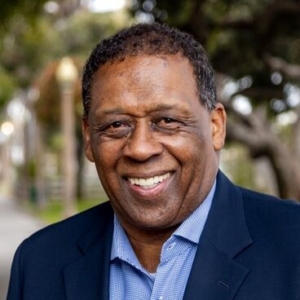
Barry Snell
1) A landmark that is meaningful to me in Santa Monica is the historic Belmar Triangle. Facing and making visible the history of Black people in our community is something I see as essential. While it’s important to acknowledge the ways that Santa Monica historically failed our Black communities, it’s meaningful to me that there is an exhibit on that site that memorializes this history today. As a city, we need to move forward so that we are serving people of all backgrounds, while remembering the legacy of the Black community and the racist history of displacement.
2) A major barrier in [historic preservation] many cases is often a lack of funds. Because of the city’s current budget crisis, this has become a problem for preserving and restoring sites that we would like to. For example, the Santa Monica Civic Auditorium requires seismic upgrades and a renovation before it could become usable again. I seek to use creative and community-centered approaches to reworking our budget and restoring city funding that we desperately need.
3) I support new housing development, but I believe that it must go hand-in-hand with other community values we have, such as inclusivity, environmental sustainability, community-centered approaches, and of course historic preservation. I seek to explore innovative methods of building the housing that we need, while still preserving our history. For example, are there opportunities for housing to be built next to or with integration of existing historical buildings? These are important questions that I would work to understand with the advocacy community.
4) As a local business owner in Santa Monica myself, I know firsthand how important it is that we have economic revitalization in our city. Like I said in my previous answer, meeting these needs can be balanced with historical preservation. Historic buildings and sites can often be an economic draw to locations. It’s important that we understand the value of historic preservation while we make upgrades and development that meets business and other needs.

Natalya Zernitskaya
1) I previously served on the administrative board of trustees of the Church in Ocean Park on 2nd and Hill and I remain a member of the church. The historical significance of the progressive organizations and movements that began in the church, as well as its physical presence where it’s located have contributed to my perspective towards historic preservation. I also temporarily lived in a home that is on the historic places registry, the E.J. Vawter House.
2) Cost, time, and land. Reports on the historical importance of a particular structure or place are costly and can take significant amounts of time to research and put together. Additionally, as a geographically small city with a significant number of jobs and high demand for homes, there can be friction between our need for new homes and our desire to preserve historic, architectural, and cultural resources. However, as addressed in question #3, there are ways for us to increase the number of homes in Santa Monica while also preserving important parts of our history.
3) I think [historic preservation and new housing development] can co-exist and provide opportunities for creative, innovative designs that can highlight history without stifling the production of new homes. For example, Frank Gehry’s Ocean Avenue Project which preserves certain historic buildings and incorporates them into the design to make the development even more iconic.
4) Places in the City that have been important to our history in Downtown and in the Neighborhood Commercial districts can help draw visitors, who would then be able to visit local businesses. With the shift from in-person shopping to e-commerce, we need to incentivize people to visit these areas in our City by encouraging more experiential and unique retail opportunities. I previously worked at a Belgian chocolate cafe in Downtown Santa Monica and we were a stop on a tour of gourmet foods in DTSM. We could explore creative ways to tie in historical landmarks and places with current (and future) businesses– maybe there’s a “History and Hamburgers” tour where folks can learn about historical landmarks and end at a local burger place. Maybe someone could create a “Santa Monica Historical Places Passport” that encourages folks to visit different businesses in or around historic places and learn what makes those places important while getting to support our local businesses. This could potentially be done in partnership between the Conservancy and the Chamber of Commerce to help build community.
About Santa Monica Conservancy
Founded in 2002, the Santa Monica Conservancy is 501(c)(3) nonprofit organization dedicated to promoting understanding of the cultural, social, economic and environmental benefits of preserving the historic resources of Santa Monica’s unique urban landscape. For information on programs, membership and the Conservancy’s Preservation Resource Center, visit www.smconservancy.org.
